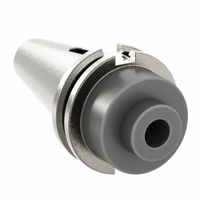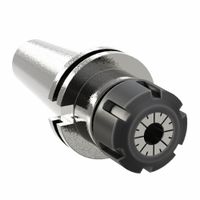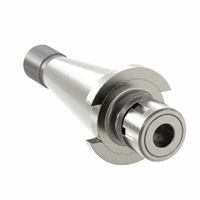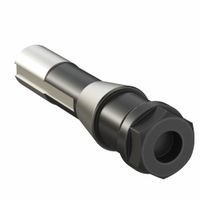Call +(254) 703 030 000 / 751 483 999 / 721 704 777
- Home
- Machining
- Toolholding Tooling Systems
- Collet Chucks
.....Read More
Frequently Asked Questions
What is a collet chuck used for?
A collet chuck is a specialized type of chuck used in machining to hold a workpiece or a tool securely in place. It is commonly used in lathes, milling machines, and other machine tools. The primary function of a collet chuck is to provide a high level of precision and accuracy in the positioning and holding of cylindrical objects.
The collet chuck consists of a collet, which is a sleeve with a cylindrical inner surface and a conical outer surface. The collet is designed to fit into the chuck body, which has a matching conical cavity. When the collet is inserted into the chuck body and tightened, the conical surfaces cause the collet to contract radially, gripping the workpiece or tool with uniform pressure around its circumference. This ensures a firm and precise hold, minimizing runout and vibration during machining operations.
Collet chucks are particularly useful for holding small-diameter workpieces or tools, where high precision is required. They are available in various sizes and types, such as ER, R8, and 5C, each designed for specific applications and machine types. The versatility of collet chucks allows them to accommodate a range of diameters by using different collets within the same chuck body.
In summary, a collet chuck is used to securely hold workpieces or tools in machining applications, providing high precision, accuracy, and stability. Its design allows for uniform gripping and minimal runout, making it ideal for tasks that require meticulous attention to detail and consistency.
How do you install a collet in a collet chuck?
1. **Safety First**: Ensure the machine is turned off and unplugged to prevent accidental activation.
2. **Select the Correct Collet**: Choose a collet that matches the size of the tool or workpiece you intend to use. Ensure it is clean and free from debris.
3. **Prepare the Collet Chuck**: Clean the collet chuck to remove any dirt or debris that might affect the installation. Inspect for any damage or wear.
4. **Insert the Collet**:
- Hold the collet with its tapered end facing the chuck.
- Align the collet with the chuck's internal taper.
- Push the collet into the chuck until it seats firmly. You may hear or feel a slight click as it snaps into place.
5. **Insert the Tool or Workpiece**:
- Slide the tool or workpiece into the collet. Ensure it is inserted to the correct depth for stability and accuracy.
- Make sure the tool or workpiece is clean and free from any oil or debris.
6. **Tighten the Collet Nut**:
- Place the collet nut over the collet and begin threading it onto the chuck by hand.
- Use a wrench to tighten the collet nut securely. Do not overtighten, as this can damage the collet or the chuck.
7. **Check Alignment and Security**:
- Ensure the tool or workpiece is properly aligned and securely held.
- Double-check that the collet and nut are properly seated and tightened.
8. **Test Run**:
- Once everything is secure, plug in the machine and perform a test run at a low speed to ensure everything is functioning correctly and there is no wobble or vibration.
9. **Final Adjustments**: Make any necessary adjustments to the tool or workpiece position if needed, and retighten the collet nut if required.
What are the different types of collet chucks?
Collet chucks are essential components in machining and tool-holding applications, providing precision and stability. The different types of collet chucks include:
1. **ER Collet Chucks**: Widely used due to their versatility, ER collets can hold a range of tool sizes. They are suitable for milling, drilling, and tapping operations.
2. **5C Collet Chucks**: Commonly used in lathes, these collets are ideal for holding small workpieces. They are known for their simplicity and ease of use.
3. **R8 Collet Chucks**: Typically used in milling machines, R8 collets are designed for quick tool changes and are popular in manual milling operations.
4. **TG Collet Chucks**: Known for their high gripping force, TG collets are used in heavy-duty machining applications. They provide excellent concentricity and are suitable for high-speed operations.
5. **DA (Double Angle) Collet Chucks**: These are used for light to medium-duty applications. They offer a good balance between precision and cost-effectiveness.
6. **SYNCHRO Collet Chucks**: Designed for synchronized tapping, these collets reduce the risk of tap breakage by compensating for minor misalignments.
7. **Hydraulic Collet Chucks**: These use hydraulic pressure to clamp the tool, providing uniform clamping force and reducing vibration, which enhances surface finish and tool life.
8. **Pneumatic Collet Chucks**: Operated by air pressure, these are used for quick and automated tool changes, often in high-volume production environments.
9. **Rubber-Flex Collet Chucks**: These provide a flexible gripping range and are used in applications requiring quick changeovers and minimal setup time.
10. **Morse Taper Collet Chucks**: Used in drilling machines, these collets are designed to fit into Morse taper spindles, providing a secure grip for drill bits and other tools.
Each type of collet chuck is designed for specific applications, offering varying levels of precision, gripping force, and ease of use.
How do you maintain a collet chuck?
To maintain a collet chuck, follow these steps:
1. **Regular Cleaning**: Remove the collet from the chuck and clean it thoroughly. Use a soft brush or compressed air to remove chips, dust, and debris. Ensure the collet slots are free from obstructions.
2. **Inspect for Wear and Damage**: Regularly inspect the collet and chuck for signs of wear, such as cracks, corrosion, or deformation. Replace any damaged components immediately to prevent further damage or accidents.
3. **Lubrication**: Apply a light coat of machine oil or a suitable lubricant to the collet and chuck surfaces to prevent rust and ensure smooth operation. Avoid over-lubrication, which can attract debris.
4. **Check Clamping Force**: Ensure the collet maintains proper clamping force. A worn or damaged collet may not hold the tool securely, leading to slippage or tool breakage.
5. **Proper Storage**: Store collets in a clean, dry environment. Use a collet rack or holder to prevent them from rolling around and getting damaged.
6. **Avoid Over-tightening**: Do not over-tighten the collet nut, as this can cause damage to the collet and the chuck. Use a torque wrench if necessary to apply the correct amount of force.
7. **Use Correct Collet Size**: Always use the correct size collet for the tool shank. Using an incorrect size can lead to poor clamping and potential damage.
8. **Regular Calibration**: Periodically check the chuck’s alignment and calibration to ensure precision in machining operations.
9. **Training and Awareness**: Ensure that all operators are trained in the proper use and maintenance of collet chucks to prevent misuse and extend the lifespan of the equipment.
By following these steps, you can ensure the longevity and optimal performance of your collet chuck.
What is the difference between a collet chuck and a drill chuck?
A collet chuck and a drill chuck are both types of tool holders used in machining, but they serve different purposes and have distinct characteristics.
A collet chuck is designed to hold tools or workpieces with high precision and is commonly used in CNC machines and lathes. It uses a collet, a sleeve with a cylindrical inner surface and a conical outer surface, which contracts uniformly around the tool or workpiece when tightened. This provides a high level of concentricity and grip, making collet chucks ideal for applications requiring precision and minimal runout. They are typically used for holding end mills, drills, and other cutting tools in milling machines. Collet chucks are available in various sizes and types, such as ER, R8, and 5C, each suited for specific applications.
On the other hand, a drill chuck is primarily used for holding drill bits in drilling machines and hand drills. It features a three-jaw mechanism that tightens around the shank of a drill bit when the outer sleeve is rotated. Drill chucks are versatile and can accommodate a wide range of bit sizes, but they generally offer less precision and grip compared to collet chucks. They are suitable for general-purpose drilling tasks where high precision is not critical. Drill chucks can be keyless, allowing for quick bit changes, or keyed, requiring a chuck key to tighten or loosen the jaws.
In summary, the main differences between a collet chuck and a drill chuck lie in their precision, grip, and application. Collet chucks offer higher precision and grip, making them suitable for precision machining, while drill chucks provide versatility and ease of use for general drilling tasks.
How do you choose the right collet size for a tool?
To choose the right collet size for a tool, follow these steps:
1. **Determine the Tool Shank Diameter**: Measure the diameter of the tool's shank that you intend to use. This is the most critical factor, as the collet must match this diameter precisely to ensure a secure fit.
2. **Check Collet Specifications**: Review the specifications of the collet system you are using. Collets are typically available in standard sizes, such as 1/8", 1/4", 3/8", 1/2", etc., or metric equivalents. Ensure the collet size matches the tool shank diameter.
3. **Consider the Collet Type**: Different collet systems (e.g., ER, R8, 5C) have varying size ranges and applications. Choose a collet type compatible with your machine and suitable for the tool's application.
4. **Verify Machine Compatibility**: Ensure the collet size is compatible with the machine's spindle or tool holder. The machine's manual or manufacturer can provide guidance on compatible collet sizes.
5. **Assess Tool and Material Requirements**: Consider the material being machined and the tool's application. For high-precision work, a tighter fit may be necessary, while for less critical applications, a standard fit may suffice.
6. **Inspect for Wear and Damage**: Before use, inspect the collet for any signs of wear or damage, which can affect its ability to hold the tool securely.
7. **Test Fit**: Insert the tool into the collet and ensure it fits snugly without excessive force. The tool should not wobble or slip when the collet is tightened.
By following these steps, you can select the appropriate collet size, ensuring optimal tool performance and safety.
What are the advantages of using a collet chuck over other types of tool holders?
Collet chucks offer several advantages over other types of tool holders:
1. **Precision and Accuracy**: Collet chucks provide superior concentricity, ensuring that the tool is held precisely on the centerline. This results in higher accuracy and better surface finish in machining operations.
2. **Gripping Force**: They offer a strong and uniform gripping force around the tool, reducing the likelihood of tool slippage during high-speed operations. This is particularly beneficial in applications requiring high torque.
3. **Versatility**: Collet chucks can accommodate a range of tool sizes with the use of different collet sizes, making them versatile for various applications without needing multiple tool holders.
4. **Reduced Vibration**: The even distribution of gripping force helps in minimizing vibrations during machining, which enhances tool life and improves the quality of the finished product.
5. **Compact Design**: Their compact and streamlined design allows for better access to the workpiece and is ideal for use in tight spaces or complex setups.
6. **Quick Tool Changes**: Collet chucks facilitate faster tool changes, reducing downtime and increasing productivity. This is particularly advantageous in high-volume production environments.
7. **Cost-Effectiveness**: While the initial investment might be higher, the versatility and durability of collet chucks can lead to cost savings over time, as fewer tool holders are needed.
8. **Improved Balance**: The symmetrical design of collet chucks contributes to better balance, which is crucial for high-speed machining operations.
9. **Durability**: Made from high-quality materials, collet chucks are durable and can withstand the rigors of demanding machining tasks, leading to a longer lifespan.
Overall, collet chucks are a preferred choice in precision machining applications due to their accuracy, versatility, and efficiency.





